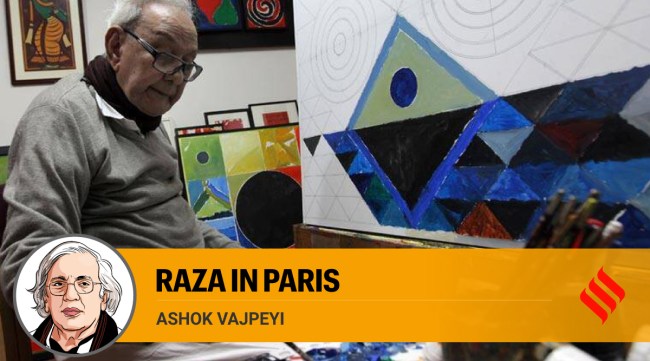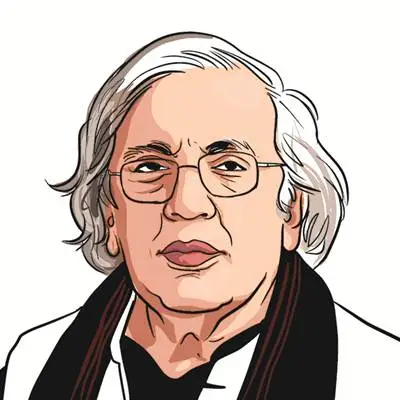Opinion Raza in Paris: An exile pining for home, his art was an extended metaphor for his zamin
Raza’s art flowed ceaselessly between many dualities: India and France, beauty and fear, the sensuous and the spiritual, modernity and memory, exile and home. His modernity was rooted in memory and nature
 For Raza, life, nature and art were so organically linked that they became almost synonymous: He lived to paint, he painted to live.
For Raza, life, nature and art were so organically linked that they became almost synonymous: He lived to paint, he painted to live. The iconic Indian modernist Sayed Haider Raza has returned to Paris in his 101st year. Almost seven years after his death in Delhi in 2016, a major show of his works, the largest ever in his artistic career and perhaps the largest ever in the West of an Indian artist in number of works and documents, is being held in the city where he lived for nearly six decades. The world-renowned museum of modern art, Centre de’ Pompidou, has organised a Raza show in collaboration with the Raza Foundation for three months, which opened on February 15, 2023. Many top ranking artists, art critics and intellectuals from India, France and the US would be exploring Raza’s vision, aesthetics and legacy in the show, in seminars, talks etc. These include Homi Bhabha, Atul Dodiya, Roobina Karode, Deepak Ananth, Annie Montaut, Charles Malamud etc. More than 60 works have been selected from India, including from Kiran Nadar Museum of Art, Piramal Museum, Jehangir Nicholson Art Foundation, Raza Foundation and private collectors. A book by way of a catalogue for the show (in two volumes in English and French) would be launched, as also an anthology of writings on and by Raza in French with the title, “Raza and the Spirit of Nature”. Two volumes of Catalogue Raisonne of Raza would also be launched at the Musee Guimet, Paris.
Raza was born in Babariya, a forest village of only 10 huts, in 1922 and spent his early life and education in Kakaiya, Mandla, Damoh and Nagpur. He landed up in Bombay, took a diploma in art from J J School of Art and, in 1947, founded with fellow artists the Progressive Artists Group. And in 1948, he refused to go over to Pakistan though his entire family shifted. On a French scholarship, Raza went to France in 1950 and spent nearly two-third of his life and artistic career in France making long yearly trips to his homeland beginning in the 1970s.
For Raza, life, nature and art were so organically linked that they became almost synonymous: He lived to paint, he painted to live. After being acknowledged as an important painter in the Parisian school, he shifted to Indian concepts, spiritual and metaphysical, and asserted that he learnt how to paint from France but what to paint from India. A master colourist, his sense of colour was inspired both by the Indian miniature traditions and the colours of real life in the many cities and rural sites in India. Deeply interested in his mother tongue, Hindi, and its poetry, he inscribed on his canvases in Devanagari script many lines and words from the Vedas, Upanishads, Bhakti, Urdu, modern poetry. He set up the Raza Foundation in 2001 with a view to support and promote artists, poets, musicians and dancers of the younger generation and funded it most generously.
Raza’s art flowed ceaselessly between many dualities: India and France, beauty and fear, the sensuous and the spiritual, image and word, modernity and memory, celebration and prayer, colour and concept, history and eternity, fury and tranquillity, exile and home. His modernity was not marked by disruption, dissonance and disinheritance: It was rooted in memory and nature, in inheritance and harmony, in consonance and peace. It was almost an alternative modernism. In his iconic explorations of the Bindu, he sought a source of energy, a locus of nature, a centre of silence, an origin of life. As a human being, noble and generous, Raza was at home with three religions Islam, Hinduism and Christianity; with three languages Hindi, French and English. His art has human glow, reflective luminosity and integrity of form. Even though highly geometrical in its last phase, Raza’s paintings, at some level, were composed as prayers for grace and peace.
Raza was an exile always pining for homeland. His art was an extended metaphor for his “zamin”, his homeland. During his birth centenary, many private museums and galleries in India held well curated shows of his works. In March 2023, shows are planned to take place in New York and Dubai. But ironically, no national institution in India including the Lalit Kala Akademi, the National Gallery of Modern Art, the Bharat Bhavan found it fit to even remember, much less to celebrate, this unquestioned master of modern Indian art.
The writer is a poet and trustee of Raza Foundation






